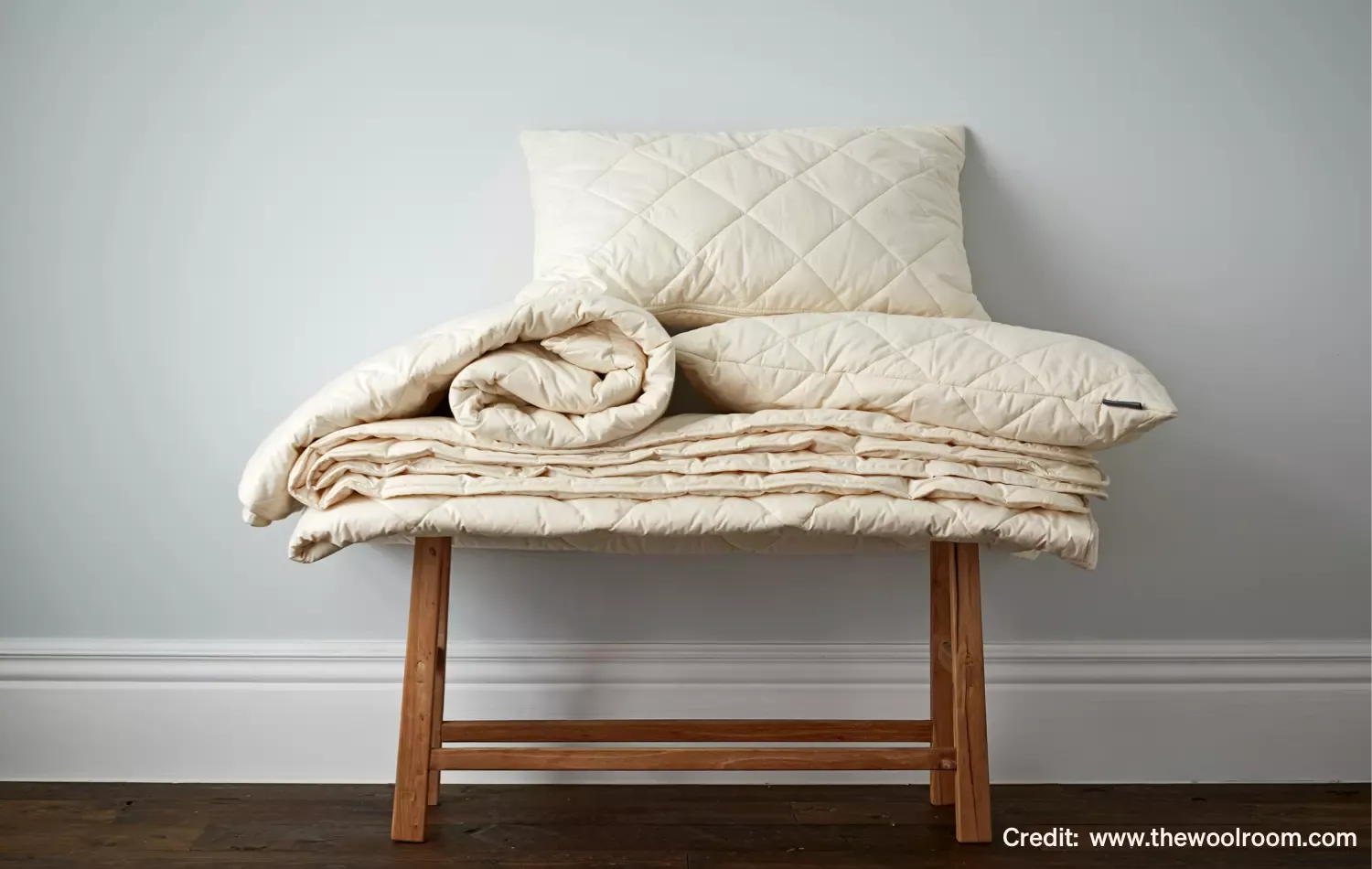The quest
for better.
Sign up to our mailing list to discover the future of beauty and wellness.
4 Minute ReadFeature by Jessica Lacey
08.05.23
You’ve changed your pillow, opened your windows, journaled your worries, made your partner swivel the bed orientation ninety degrees, meditated for a full five minutes (okay two and half), downed a herbal tea and left your phone downstairs but still you’re not sleeping. What now?
For clarification purposes, this does not mean snuggling under a blanket with the DNA of a scouring pad, reminiscent of boarding school days past. Wool bedding has joined us in the 21st century and looks like any other civilized and machine washable duvet. To say that wool bedding is on the precipice of becoming a mass-adopted wellbeing trend would be doing it a disservice because the sheer weight of science-led research studies backing wool bedding mean it’s less of a moment and more of a full on movement. In short, it’s what we should have been sleeping under all along.
The ideology of sleeping under duck and goose down has long been implanted into our desire cortexes; all that exquisitely airy, puffed-up softness collected from a crystalline Hungarian winterscape or some other frost-laden tundra. It paints a beautifully Tolstoyan scene but in reality, this misplaced luxury is what’s stopping you from getting a good night’s sleep. As soon as people started sleeping soundly under weighted blankets, the plumage jig was up. Add to that the galling animal welfare reports of live plucking, (every bit as horrifying as you’d imagine), and it seemed we’d all be faced with switching to synthetics. Fear not, the answer is pleasingly organic and cottage core, wool bedding.

Wool is scientifically proven to make you sleep better. In a pivotal sleep study, participants observed zedding under wool spent 25% more time in Stage 4 Restorative REM sleep, those hours between 2am and 5am, when cells regenerate and the body heals itself. Participants reported sleeping more peacefully and waking up feeling well rested.
The physiological make-up of wool has the added benefit of diffusing weight over pressure points and evidence shows that when you sleep on wool underlay, you shift around less to avoid tender points, finding a comfortable position more easily.
Sleep scientists have discovered that the main cause of nighttime waking is not our racing, spaghetti-like thoughts but the diminishment of the body’s ability to thermoregulate during deep sleep. Wool creates a stable sleep environment, thus helping the body regulate its own temperature to maintain a balanced sleep thermostat.

The inherent natural 3D crimp of the wool fibre traps pockets of still air, thermo-insulating your skin from the cold environment. Studies show that when pitted against feather down and synthetics, on a cold night, wool will warm you up faster than both feather down or synthetic duvet equivalents.
Wool is an active fibre and as such, is unrivalled in its moisture transport abilities. “Wool absorbs perspiration as you sleep and acts as a filter system, releasing it into the atmosphere during the day, therefore managing humidity as you sleep,” explains Chris Tattersall, owner and sleep expert at Woolroom.
Nowhere near as saucy as silk but wearing merino wool sleepwear showed that at 17°C, (the body’s optimal sleep temperature range), wool sleepwear significantly increased sleep onset quicker than cotton.
More wool is needed to create the same thermal comfort as down and is therefore heavier. Just like weighted blankets, this added load has the effect of calming the parasympathetic nervous system.

Those who suffer from asthma or other allergies are more sensitive to house dust mites. “Wool filling, through its ability to maintain a dry state, does not allow house dust mites to live within the bedding environment as there is no food source,” explains Chris Tattersall.
Less shifting about and fewer nighttime waking episodes spell out a sounder sleep for your sleep buddy but the creation of a micro climate means wool bedding also regulates temperature across the bed. According to a study by Woolroom, 71% of us sleep at a different preferred temperature to our partner, so if you have a hot partner, they’ll cool down rather than making you toasty too.
Sleep is a super power. Poor sleep results in poorer quality of life; impairing cognitive function, weakening the immune system, lessening mental resilience and compromising cardiovascular health. Getting your sleep sorted touches every aspect of wellbeing and there are fewer things more fundamental to our long-term health. The melee of modern life is unavoidable and so should it be, let's all relish buzzing throughout the day but have the tools to stop it entering our bedrooms and compromising our sleep. As it turns out, it really is those sheep that get us to sleep.
References:
With thanks to the International Wool Textile Organisation for resource access and full research studies.
IWS Interior Textiles Technical Information Letter 46, 21st November 1990
Umbach, K. H.(1986) 'COMPARATIVE THERMOPHYSIOLOGICAL TESTS ON BLANKETS MADE
FROM WOOL AND ACRYLIC-FIBRE-COTTON BLENDS', Journal of the Textile Institute, 77: 3, 212 — 222
Scott, S (1979) Weight gain and movement patterns of very low birthweight babies nursed on lambswool, University of Cambridge
Dickson, P.R. (1984), The Medical Journal of Australia, January 21, 1984, p87-89
The effects of fabric for sleepwear and bedding on sleep at ambient temperatures of 17°C and 22°C, Nature and Science of Sleep, (2016)
Pittsburgh Sleep Quality Index when sleeping on wool underlays. Kiyak, E., Akdemir, N., Fesci, H. (2010), Australian Journal of Advanced Nursing, 26:3, 47-52.